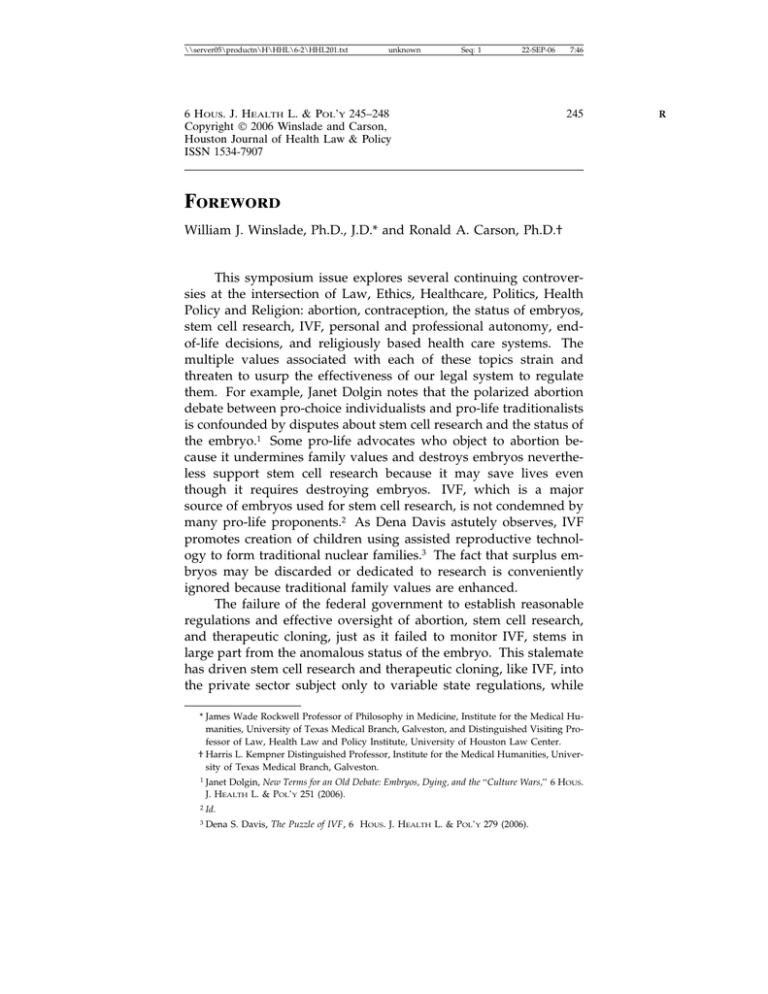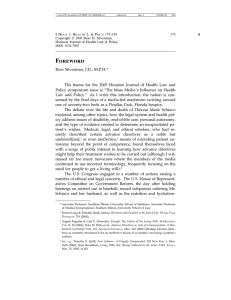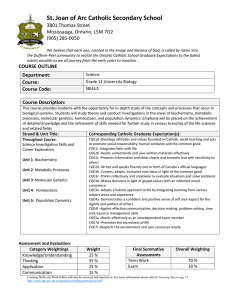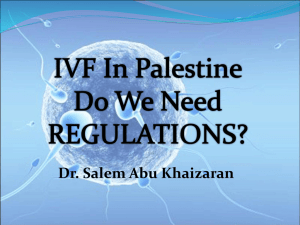6 H . J. H L. & P ’
advertisement

\\server05\productn\H\HHL\6-2\HHL201.txt unknown Seq: 1 22-SEP-06 6 HOUS. J. HEALTH L. & POL’Y 245–248 Copyright 2006 Winslade and Carson, Houston Journal of Health Law & Policy ISSN 1534-7907 7:46 245 FOREWORD William J. Winslade, Ph.D., J.D.* and Ronald A. Carson, Ph.D.† This symposium issue explores several continuing controversies at the intersection of Law, Ethics, Healthcare, Politics, Health Policy and Religion: abortion, contraception, the status of embryos, stem cell research, IVF, personal and professional autonomy, endof-life decisions, and religiously based health care systems. The multiple values associated with each of these topics strain and threaten to usurp the effectiveness of our legal system to regulate them. For example, Janet Dolgin notes that the polarized abortion debate between pro-choice individualists and pro-life traditionalists is confounded by disputes about stem cell research and the status of the embryo.1 Some pro-life advocates who object to abortion because it undermines family values and destroys embryos nevertheless support stem cell research because it may save lives even though it requires destroying embryos. IVF, which is a major source of embryos used for stem cell research, is not condemned by many pro-life proponents.2 As Dena Davis astutely observes, IVF promotes creation of children using assisted reproductive technology to form traditional nuclear families.3 The fact that surplus embryos may be discarded or dedicated to research is conveniently ignored because traditional family values are enhanced. The failure of the federal government to establish reasonable regulations and effective oversight of abortion, stem cell research, and therapeutic cloning, just as it failed to monitor IVF, stems in large part from the anomalous status of the embryo. This stalemate has driven stem cell research and therapeutic cloning, like IVF, into the private sector subject only to variable state regulations, while * James Wade Rockwell Professor of Philosophy in Medicine, Institute for the Medical Humanities, University of Texas Medical Branch, Galveston, and Distinguished Visiting Professor of Law, Health Law and Policy Institute, University of Houston Law Center. † Harris L. Kempner Distinguished Professor, Institute for the Medical Humanities, University of Texas Medical Branch, Galveston. 1 Janet Dolgin, New Terms for an Old Debate: Embryos, Dying, and the “Culture Wars,” 6 HOUS. J. HEALTH L. & POL’Y 251 (2006). 2 Id. 3 Dena S. Davis, The Puzzle of IVF, 6 HOUS. J. HEALTH L. & POL’Y 279 (2006). R \\server05\productn\H\HHL\6-2\HHL201.txt 246 unknown Seq: 2 22-SEP-06 7:46 HOUS. J. HEALTH L. & POL’Y leaving the volatile controversy about the status of embryos diffused but unresolved.4 The conscience clause and emergency contraception dispute is a further illustration of a similar dilemma. Some pharmacists believe that they should be able to refuse to fill physicians’ prescriptions for contraceptive devices approved by the FDA because they destroy embryos.5 That pharmacists, on the basis of their personal values, should be able to disrupt the legally established physician-patient relationship and prescribing laws may seem preposterous. But it is based on the analogy to physicians or Catholic hospitals refusing to perform abortions on the basis of their religious beliefs and moral objections to the destruction of embryos. The legal and ethical uncertainty of the status of the embryo pervades not only abortion and stem cell research but also contraception. Leslie Griffin carefully explores and cogently explains why under United States constitutional law concerning religion pharmacists should not be allowed to become a law unto themselves.6 The notion that professional autonomy and personal moral beliefs of pharmacists can trump not only physicians’ right to prescribe but also patients’ right to obtain lawful drugs is an excessive extension of a conscience clause. Yet this issue is also currently unresolved in the legislatures and the courts. Barbara Noah claims that Catholic teaching on end-of-life care is ambiguous about the moral quandaries raised by modern medicine’s technological prowess at prolonging life.7 But her informative discussion of Catholic guidance regarding when and whether to continue or to forgo life-sustaining measures at least partially belies that claim.8 Noah’s paper is peppered with references to canonical commentary which acknowledges that faithfulness to Catholic teaching is not about unquestioning obedience but rather requires an “intelligent and reflective response.”9 Even the Declaration on Euthanasia, which condemns the intentional causing of death by commission or omission, affirms that there is no obligation to 4 See, e.g., Sheryl Gay Stolberg, First Bush Veto Maintains Limits on Stem Cell Use, N.Y. TIMES, July 19, 2006, at A1. 5 Leslie C. Griffin, Conscience and Emergency Contraception, 6 HOUS. J. HEALTH L. & POL’Y 305 (2006). 6 Id. 7 Barbara Noah, The Role of Religion in the Schiavo Controversy, 6 HOUS. J. HEALTH L. & POL’Y 327 (2006). 8 Id. 9 Id. \\server05\productn\H\HHL\6-2\HHL201.txt FOREWORD unknown Seq: 3 22-SEP-06 7:46 247 initiate or continue burdensome life-prolonging measures or procedures that are disproportionate to prospects for recovery.10 If Catholic teachings are to be useful to patients facing death and to their families, much will depend on the interpretation of such terms as “burdensome” and “disproportionate.” A common confusion arises when the question of what counts as a burden is applied to a technical procedure. For example, was the medical administration of nutrition and hydration into Ms. Schiavo’s body burdensome to her? Surely not in a physical sense. This technique is relatively routinely used with severely dehydrated patients and with patients who have lost the capacity to take food by mouth. But the determination of burdensomeness in the Schiavo case was not a technical matter, it was a moral one. As Noah rightly observes, principles (she is referring to Catholic principles, but her observation applies to moral principles generally) are not meaningful prima facie but only as they are interpreted by dying individuals and by those who know them best and care for them.11 Knowing that Ms. Schiavo was a Catholic may tell us something pertinent but nothing definitive about what medical decisions she might have made had she not lost the capacity to decide for herself. Those who know her best and who care for her are the most likely candidates to render a conscientious interpretation of how she is likely to have made use of the moral resources of her faith. Furthermore, if questions of faith are to be considered by the courts in disputed cases, the only hedge against the risk of allowing private struggles of conscience to be hijacked by political or religious opportunists is to conduct respectful legal inquiry into an incapacitated patient’s moral values. Noah is particularly incisive in her criticism of “sound-bite” approaches to matters of faith and in her call for a more nuanced public discussion of the legitimate role of religious beliefs and moral values in end-oflife decision-making.12 The bizarre but prolonged furor about who should have the legal authority to determine the fate of Ms. Schiavo (and others similarly situated)—her husband or her parents, the state or federal legislatures, or the state or federal courts—has shifted attention away from the unresolved status of the embryo to the uncertain status of the helpless and vulnerable vegetative patient.13 But the underlying 10 Sacred Congregation for the Doctrine of the Faith, Declaration on Euthanasia, May 5, 1980. 11 Noah, supra note 7. 12 Noah, supra note 7. 13 Janet Dolgin, New Terms for an Old Debate: Embryos, Dying, and the “Culture Wars,” 6 HOUS. J. HEALTH L. & POL’Y 251 (2006). \\server05\productn\H\HHL\6-2\HHL201.txt 248 unknown Seq: 4 22-SEP-06 7:46 HOUS. J. HEALTH L. & POL’Y value conflicts are similar. Abortion causes death of the fetus and removing life support causes death of the vegetative patient. The legal system is bogged down by the acrimonious debates and political maneuvering of pro-life and pro-choice advocates. In order to get beyond acrimony and posturing that end in stalemate, it may be useful to place disputes between those who think beginning- and end-of-life decisions are personal choices and those who believe that such decisions should be strictly regulated, if not prohibited altogether, in the broad context of an ongoing debate about cultural matters which are integral to our society’s collective self(re)definition. From this perspective, such debates are not likely ever to be settled definitively but only provisionally as we continue to try to make sense, to borrow Janet Dolgin’s provocative formulation, of self, suffering, and the shape and scope of family relationships.14 Finally, Larry Singer’s article reminds us that such debates are mediated by social institutions such as congregations and courts, corporations and clinics.15 Singer makes the case that Catholic hospitals continue to have a distinctive role to play in that process of mediation. In particular, Catholic hospitals’ traditional commitment to the patient as person can provide an important alternative to the prevailing bottom-line focus of healthcare organizations. Taken together, these articles demonstrate how difficult it has become to have a civil public conversation about the common life of our society when the moral languages at our disposal are so various, even disparate. Given the cultural pluralism of American society and the paucity of venues and practices conducive to dialogue about things that people hold dear, it is not surprising that we often talk past each other or resort to shouting each other down. Moreover, the labels we used to use as shorthand for our political and religious alignments, such a “conservative” and “liberal,” are no longer serviceable when traditional alliances shift in often unpredictable ways depending on the issue in play. Nonetheless, and notwithstanding the prevailing cultural pluralism, we are obliged to make some common sense of our common life regarding such matters as bearing and bringing up children, protecting the vulnerable, and caring for the dying. These articles make valuable contributions to that effort. 14 Id. 15 Lawrence Singer, Does Mission Matter?, 6 HOUS. J. HEALTH L. & POL’Y 357 (2006).






